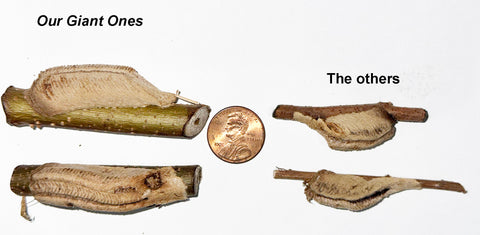For guaranteed live arrival, choose next day shipping when ordering mantids, order may be canceled. DELAYS from WEATHER ALERT Need help? Contact CLICK
Wholesale inquiries
Menu
-
- Home
- Contact
- Search
-
Shop
- Live Feeder Insects
-
Supplies
- Habitats
- Feeders
- Feeders and Microfauna Breeding Supplies
- Bioactive Kits
- Bioactive Supplies
- Containers
- Insect Culture Cups
- Insect Culturing Cups and Lids
- Classroom Projects
- Live Air Plants bioactive
- Substrates
- Lighting and Heating
- Cages, Habitats, Bug Boxes, Vivariums, Insectariums
- Bark
- Shipping supplies, Heat packs, cold packs, containers
- Bio-Active
- Plants
- Mantis Gallery
- Usmantis Reviews
- Praying Mantis
- Mantis
- Praying Mantis eggs ootheca for pest control
- BioActive Supplies
- Help Videos
- Top 5 Praying mantis as pets,
- Blog
-
Shop By Family
- Praying Mantis
- Care Sheets
- Track Order
- Live Feeder Insects
- Wholesale prices for bulk orders
- FAQ
-
- Home
- Search
- About us
- Shipping
- Track Orders
- Contact us
- Blog
-
Sitemap
- Reviews
- Film production resources
- Wholesale
- FAQ
- Login
-
English

For guaranteed live arrival, choose next day shipping when ordering mantids, order may be canceled. DELAYS from WEATHER ALERT Need help? Contact CLICK
Wholesale inquiries
Add description, images, menus and links to your mega menu
A column with no settings can be used as a spacer
Link to your collections, sales and even external links
Add up to five columns
Add description, images, menus and links to your mega menu
A column with no settings can be used as a spacer
Link to your collections, sales and even external links
Add up to five columns
Invasive? The lies about Chinese mantis.
March 09, 2024 2 min read
Not invasive ! Naturalized for more than a century thriving and helping to balance our flora and fauna’s. Nature knows best growls Craig Baker when someone takes a shot at mantids by calling them invasive or “It kills hummingbirds “ that’s infuriating he says! One photo of the hummingbird that got snagged by a mantis and it’s all gone viral. “Imbeciles he rants! “ Artificial intelligence can’t come fast enough! People aren’t thinking anyway.
What needs to be taken into account is the millions of mantids in the ecosystem and why the Tenodera sinensis thrives. Seemingly taking over or crowding the other species isn’t a just call. They are thriving because it is their place to live for reasons we may not completely understand. The prey that they are devouring destructive pests such as Japanese beetles, stink bugs, lantern flies, longhorn beetles and a miriad of other insects being kept in check best way possible considering the challenges of our environment. I also am not looking for and argument but am taking this time to explain as you have the capacity to understand. The damage is done not by the flora and fauna which strive to flourish under these conditions but by humans.
Nature is fixing these things best it can, even the most concerned people don’t understand the big picture until it’s taken its course. In some case yes we need to harness the blight and infestation of certain species, but the average human is influenced by viral photo of Chinese mantis eating a hummingbird, no one thinks to mention or see the billions of mantis nymphs that are feeders for the hummingbirds.
I will say there is a regional decline with Chinese mantis this year, 2024 and there is an interesting trend with the Tenodera augustipennis or long winged mantis who’s ootheca commonly mistaken for the Carolina species.

They seem to be forming a subspecies and have been evolving from my observations possibly a cross breed which is quite a bit larger than they have been known to be. See here the same species and differences in size between the ootheca. 4-5 times in size!
(Oh and keep your cats indoors if your worried about hummingbirds 😂) And praying mantis are really great pets, you wouldn’t believe it!
Also in Praying Mantis News

Invasive claims and irresponsible advice
April 13, 2024 2 min read
This article is addressed to those who don’t understand how an ecosystem and environment works. There are deeper factors requiring serious consideration
Read More

Is it time for insect researchers to consider their subjects’ welfare?
April 08, 2024 3 min read
Recent evidence suggests that at least some insect species might plausibly feel pain. This Perspective argues that researchers need to rethink the welfare implications of these findings for experiments that use insects.

My Awesome Summer by P. Mantis Children’s book
April 07, 2024 1 min read
Recent Articles
-
Invasive claims and irresponsible advice
April 13, 2024
-
Is it time for insect researchers to consider their subjects’ welfare?
April 08, 2024
-
My Awesome Summer by P. Mantis Children’s book
April 07, 2024
-
Toxodera
April 06, 2024
-
Feeders best practices for mantis NO Crickets
March 30, 2024
-
Fruit fly husbandry, Have some Culture-Learn how to Fly!
March 14, 2024
-
Invasive? The lies about Chinese mantis.
March 09, 2024
-
Usmantis News updates
February 24, 2024
-
US Air Force studies pest control for airplanes Praying mantis solution
February 16, 2024
-
This bug is Lantern fly worst enemy
February 16, 2024
Categories
- animal husbandry
- best feeders
- best mantis for pest control
- breeding praying mantis
- buy praying mantis
- Cannabis
- crickets
- dormitory pet
- Drosophila
- education
- egg
- entomology
- fertility
- flightless fruit flies
- Flower mantis
- Friendly Bugs For Cannabis
- fruit fly culture
- geometric morphometrics
- Ghost mantis
- happy experience with pets
- Hydei
- Hymenopodidae
- Hymenopus coronatus
- invasive
- keeping insects alive
- Lucky mantis
- Major League baseball Perez Kisses Lucky Mantis!
- make money
- mantis for dummies
- mantis ooth
- Mantodea
- melanogaster
- mimicry
- mismolt
- new species
- ooth
- ooth care
- ootheca
- P paradoxa
- pest
- Pest control
- pet nutrition
- praying mantis
- praying mantis care
- praying mantis for sale
- reptile feeders
- School project
- scientific research
- Sexing praying mantis
- Shipping
- signalling
- stem
- stenophylla
- Store news
- stress from shipping
- usmantis
- we buy mantis
Menu Title
This section doesn’t currently include any content. Add content to this section using the sidebar.
Subscribe
Sign up to get the latest on sales, new releases and more …
Invalid Password
Enter